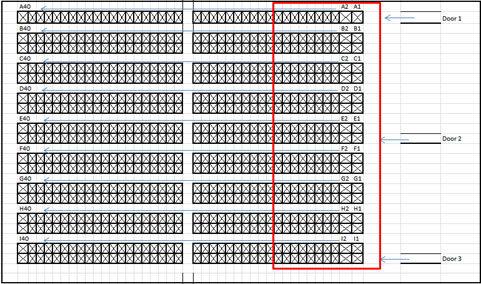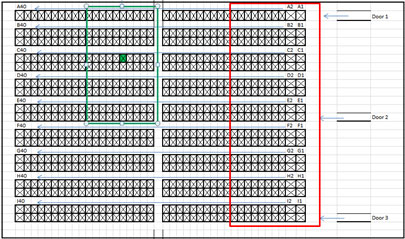Task Interleaving – Optimize Internal Warehouse Movements
Publish Date: January 23, 2018In today’s world of mass consumption where there is a vast demand for distribution centers of larger sizes, managing such centers have become very complicated and challenging especially when labor costs minimization is a concern. Most of the workers working time are spent in traveling between a source and destination points which cause deadheading. There is a need for optimal assignments between tasks and workers.
Task Interleaving is one of the most interesting concepts in Warehouse Management System (WMS) theory and practice. It is an advanced productivity practice enabled in SAP Extended Warehouse Management (EWM). Task interleaving is designed to reduce deadheading—i.e., when a product is picked and dropped off at a dock by a worker and then returns without performing any useful tasks along the way to the picking area. In majority operations, some workers are dedicated to picking, while others are devoted to put-away. Task interleaving is most common in operations with workers that have permission to do both. A typical use case for interleaving application is to combine picking and putaway queues in one location, where the operation/activity areas for both are in the same physical location. When a task in one queue is finished, the system will always jump to the next queue and searches for the next earliest/nearest task.
In SAP EWM, set RF interleaving for resource types. You assign each interleaving-relevant queue to a queue type and a queue sequence. In RF Interleaving, the resource processes a warehouse task of a queue and the subsequent warehouse task comes from another queue, based on the defined queue sequence. In standard RF function, the resources keep on processing the task of the same queue until it is assigned to a different queue.
You can use the BADI EX_TSKINTL_SELECT to influence warehouse order selection using resource management in task interleaving. The BADI includes the method WO_COLLECT. The method only runs when task interleaving is activated in the RF environment.
Following customization are the prerequisites for the RF interleaving to function.
Define the queue type.
In Customizing for Extended Warehouse Management, select Cross-Process Settings ➜ Resource Management ➜ Define Queue Type.
You have defined the queue sequence. By doing this, the processing sequencing of the warehouse tasks is defined.
On the SAP Easy Access screen, select Extended Warehouse Management ➜ Master Data ➜ Resource Management ➜ Maintain Queue Sequence for Resource Group.
Assign the queue to a queue type.
In Customizing for Extended Warehouse Management, choose Cross-Process Settings ➜ Resource Management ➜ Define Queues.
Queues can be excluded from the queue sequence.
On the SAP Easy Access screen, choose Extended Warehouse Management ➜ Master DataResource Management ➜ Maintain Queue Sequence for Resource Group.
Resource types can be excluded.
In Customizing for Extended Warehouse Management, choose Cross-Process Settings ➜ Resource Management ➜ Define Resource Types.
In SAP WM, task interleaving is not standard functionality however with some development effort similar functionality can be achieved in the RF environment. We were successful in implementing the same solution in one of our clients where the warehouse operators are automatically assigned a picking or replenishment Transfer order once the operator completes a put-away Transfer order. I would like to discuss the concept we used to make this solution functional. Let us understand this process using an example of warehouse depicted below.
Prerequisites in the above development-
Two new custom RF transactions will be added to the RF Menu
Putaway + Replenishment
Putaway + Picking
When a user logs into the RF menu, they will be required to choose the transaction any one of the above transactions. Once the user scans the pallet/ pallets and puts away, the system will bring in the next TO / pallet based on the proximity to the bin instead of next pallet within the same process. The process of interleaving between put-away and replenishment or put-away + picking will continue until the user comes out of the transaction.

Assuming the bins within the red border are forward pick bins or pick faces, we will exclude bins from interleaving. No putaway TO will be assigned if the bin location falls in the marked red area.
We maintained a custom table where the storage bins to be excluded from interleaving is kept.
Inclusion of bins for Interleaving –
If Put-away bin location is out of Red border area, then the only system will propose picking or replenishment TO.
We can define square shape area for interleaving in each aisle around particular bin in which put-away is being done. If put-away is done in a specific Aisle & in a particular bin which falls under Green square shape area (marked in Green around Aisle C), the system will be configured for picking or replenishment TO based on the type of queue the user is logged in.
In below example, we assume that put-away is getting done in Aisle C in a bin C-25-01 (marked in a green dot).

We can sort staging TO bins which belong to A & B in ascending order & staging TO belong to D & E in descending order. So it will be in sequence from A to E.
| Aisle | Putaway Bin Position | Bin From | Bin To |
|---|---|---|---|
| C | C-25-01 | C-20-01 | C-30-01 |
| C | C-25-01 | A-20-01 | A-30-01 |
| C | C-25-01 | B-20-01 | B-30-01 |
| C | C-25-01 | D-20-01 | D-30-01 |
| C | C-25-01 | E-20-01 | E-30-01 |
| B | B-25-01 | B-20-01 | B-30-01 |
| B | B-25-01 | A-20-01 | A-30-01 |
| B | B-25-01 | C-20-01 | C-30-01 |
| A | A-25-01 | A-20-01 | A-30-01 |
| A | A-25-01 | B-20-01 | B-30-01 |
With the above process, the customer could increase the productivity of the warehouse resource by 20 to 30 percent. Task interleaving is a great way to improve productivity, especially for pallet movements, but change management must be addressed carefully.
Leverage YASH Technologies’ EWM Expertise to Transform Your Value Chain. Get your Free Assessment
Abhishek Banerjee -SAP MM/WM Practice@YASH Technologies
Reference: https://help.sap.com/doc/57574d15fa1d414792d74047b66c3e41/7.0.4/en-US/f8980325ca584637ab9861db152cff70.html















